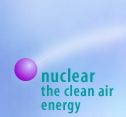| History
|
Dec. 2, 1942 |
First controlled nuclear chain reaction:
University of Chicago; Dr. Enrico Fermi; the Chicago
Pile 1, the first demonstration reactor. |
|
1947 |
Atomic Energy Act: signed by President Harry S.
Truman. The first major amendment to the Act was signed
in 1954 by President Eisenhower, which placed the
nuclear energy industry under civilian control and
created the Joint Congressional Committee on Atomic
Energy. |
|
Dec. 1957 |
The first commercial nuclear power plant began
operation in Shippingport Pa. |
|
April 1977 |
Reprocessing of nuclear fuel in the United
States was banned by President Jimmy Carter, following a
temporary hold on reprocessing initiated by President
Gerald Ford. President Ronald Reagan lifted that ban in
October 1981. |
|
Mar. 28, 1979 |
The worst U.S. nuclear power plant accident
occurred at the Three Mile Island Unit 2 reactor near
Harrisburg, Pa. Although a small amount of radiation was
released, no injuries, deaths or discernible direct
health effects were caused by the TMI-2 accident. The
accident was due to a combination of equipment failure
and the inability of plant operators to understand the
reactor's condition.
In response to recommendations by
the Kemeny Commission, appointed by President Carter to
investigate the accident, the industry established the
Institute of Nuclear Power Operations (INPO) in Oct.
1979. INPO set performance objectives, criteria, and
guidelines for overall nuclear plant operations, and
started conducting regular evaluations of nuclear
plants. INPO began monitoring performance indicators in
1981 and formed the National Academy for Nuclear
Training in 1985 to accredit nuclear utilities' training
programs for plant operators and supervisors of
operations. In response to INPO's report to the
Commission in Mar. 1989, ten years after the accident,
John Kemeny, chairman, said: "The [industy's]
improvements over the past decade have been impressive
and are very reassuring." |
|
Jan. 7, 1983 |
President Ronald Reagan signed into law the
Nuclear Waste Policy Act, which was amended in 1987. It
authorized and required the U.S. Department of Energy
(DOE) to locate and build a permanent repository and an
interim storage facility and develop a transportation
system to safely link nuclear plants to the facilities.
The Act obligated DOE to begin
disposal of high-level radioactive waste from commercial
nuclear facilities by January 31, 1998. To date, that
process has not begun due to economic reasons. Also, no
site has been selected for the interim storage
facility. |
|
1983-1984 |
Nuclear power surpassed natural gas in
electrical generation in 1983 and became the
second-largest source of electricity in 1984, after
coal. |
|
April 1986 |
The worse nuclear power plant disaster in
history occurred at the Chernobyl Unit 4 reactor in the
Ukraine, former Soviet Union. The Chernobyl accident was
the product of a severely flawed reactor design—one that
could never have been licensed in the U.S. - and serious
mistakes were made by the plant operators, who violated
procedures intended to ensure safe operation of the
plant. The accident destroyed the reactor, killed 31
people, and contaminated large areas of Belarus, Ukraine
and the Russian Federation. The Chernobyl disaster was
the only time in the history of commercial nuclear
electricity generation that radiation-related fatalities
occurred. |
|
February 25, 1999 |
Four midwestern utilities—Northern States Power
Co., Wisconsin Electric Power Co., Wisconsin Public
Service and Alliant Energy—announced the formation of a
nuclear management company to consolidate management of
the companies’ nuclear power plants. This consolidation
marked the first venture of this nature in the nuclear
industry. The utilities operate seven reactors in Iowa,
Minnesota and Wisconsin. |
|
July 13, 1999 |
The nation’s first completed sale of a nuclear
power plant occurred with Entergy Nuclear’s purchase of
Boston Edison’s Pilgrim station. Entergy’s purchase
increased the company’s holdings to six reactors in four
states: Massachusetts, Arkansas, Louisiana and
Mississippi. |
|
March 23, 2000 |
For the first time in history, the NRC approved
the renewal of operating licenses for a commercial
nuclear power plant. The 20-year license extension was
for two reactors at Baltimore Gas and Electric’s Calvert
Cliffs plant. During the 22 months that the NRC reviewed
the Calvert Cliffs submittal, license renewal
applications for another six of the nation’s 103
reactors were filed with the agency, and utilities
owning another 22 reactors informed the NRC of their
plans to apply by the year 2003. Original nuclear plant
licenses are issued for a 40-year operating
period. |
|
April 2, 2000 |
After completion of a six-month pilot program
involving 13 reactors in November 1999, the NRC began
implementing industrywide a new nuclear power plant
oversight process designed to better focus agency and
industry resources on issues most critical to power
plant safety. The Union of Concerned Scientists was
among the groups that endorsed the move to a more
objective oversight
system. | |







